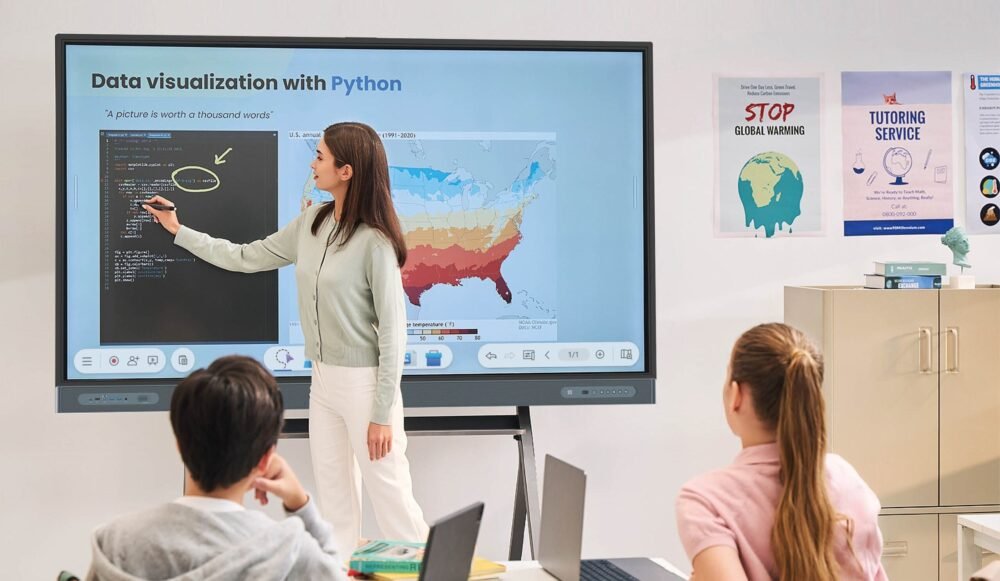Manish Bakshi, Managing Director of BenQ Middle East, explains how AI can enhance learning and teaching while highlighting innovative software solutions that can enhance the classroom experience
Since ChatGPT entered the mainstream in late 2022, teachers and school leaders have been embracing new ways to integrate Artificial Intelligence (AI) into the classroom. While AI tools like chatbots have sparked debates about their impact on student learning, they also offer new opportunities to enhance the classroom experience for both students and teachers. Instead of fearing AI, educators can harness its capabilities to ease workloads, streamline processes and make material more accessible to all students by incorporating AI into their classrooms.
The Federal Government’s Framework for Generative AI in Schools says that AI technology has “great potential to assist teaching and learning and reduce administrative workload.” Increasingly accessible and sophisticated, AI provides opportunities not previously possible. Chances are, you’re already using AI apps in your classroom, and you might not even realise.
A 2023 report found that just over 70% of primary teachers and up to 80% of secondary teachers were using AI tools in their work. Teachers said AI tools saved them time, allowing them to quickly develop learning tasks for students. Time saving, reducing administrative stress, altering lessons to suit different learning needs and making lessons more interactive were also cited as key benefits to using AI. When managed well, and with necessary safeguards in place, AI can provide notable advantages for teachers and students.
 BenQ is a global leader in display solutions and classroom technology, and is supporting schools to use AI technology safely and productively. BenQ Middle East Managing Director Manish Bakshi says, “AI in education is becoming a powerful tool, and the use of AI in classrooms will continue to increase. Many brands are releasing products that contain AI software to assist educators.”
BenQ is a global leader in display solutions and classroom technology, and is supporting schools to use AI technology safely and productively. BenQ Middle East Managing Director Manish Bakshi says, “AI in education is becoming a powerful tool, and the use of AI in classrooms will continue to increase. Many brands are releasing products that contain AI software to assist educators.”
Bakshi highlights several areas of learning and teaching that can be enhanced by AI technology.
Digital content libraries allow students to access various academic and research materials (e-books, scholarly articles, journals, multimedia clips), he says. “Educational apps such as Kahoot promote interactive learning. Powerpoint presentations help present learning materials in a more visual manner,” he adds.
“Posting homework assignments online increases accessibility for students and can help improve students be more organised. Online grading systems help streamline processes for teachers. Use of interactive games build fundamental skills for young students (particularly ECEC),” says Bakshi.
Interactive whiteboards, computers and VR headsets can all be leveraged in classrooms for teaching and learning. These devices come with a range of software solutions to enhance learning, catering for different learning styles and a broad scope of activities.
A small scale study conducted in a tertiary US context demonstrated the potential of technology to improve student engagement. The study found that student participation in class, preparation for class, attentiveness, learning and impression of the course and instructor tend to improve when technology is well utilised.
“BenQ Interactive whiteboards are an example of technology that helps benefit both teachers and students,” says Bakshi. “Software such as AMS, EZWrite 6 and Instashare help create a more seamless teaching experience for teachers and encourage students to actively participate.”
For teachers, AI presents many opportunities to improve their teaching practice and build on their existing skills. He says, “Generative AI will provide instant access to teacher development as well as providing support in a range of areas, for example, developing first drafts of whole class and individual planning that is well structured and sequenced.
“AI can also be used to analyse student performance data and tailor lessons to individual learning needs. For example, the new models of the BenQ IFP have the EZWrite 6 software, which allows teachers to teach without boundaries. Teachers can write, draw, insert text, or add images. This helps engage every learner through AI-powered text-to-speech and multi-language translation
“Additionally, software like InstaShare 2 facilitates seamless screen sharing to encourage participation. The new AI update allows live identification of insects and plants.”
With AI technology evolving quickly, staying up to date with all available resources and best practice for using them may seem complicated. To make things simple, BenQ has released a comprehensive, easy-to-follow guide to AI, detailing apps which are compatible with the BenQ Board. Much more than your average whiteboard, BenQ Board leverages AI software to improve file accessibility and sharing, provide enhanced security, reach students working remotely, translate content into multiple languages, and from text-to-speech, and much more.
To find out how you could make the most of AI software and technology in your classroom, download the free BenQ ebook.








